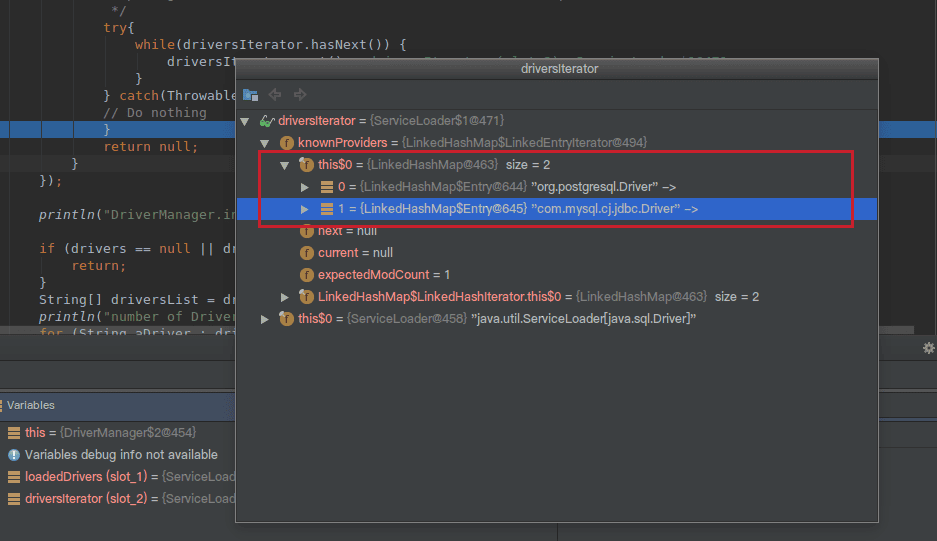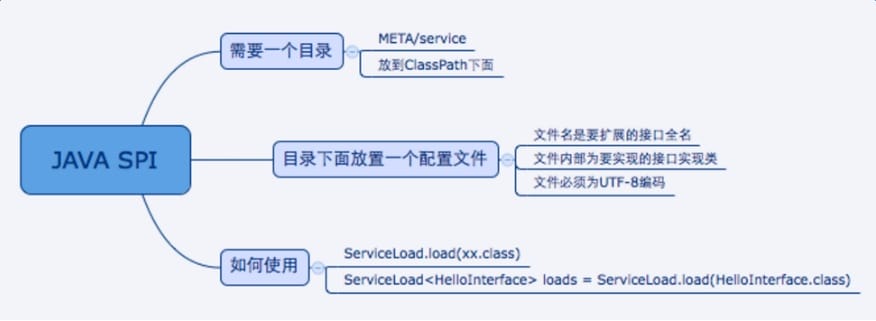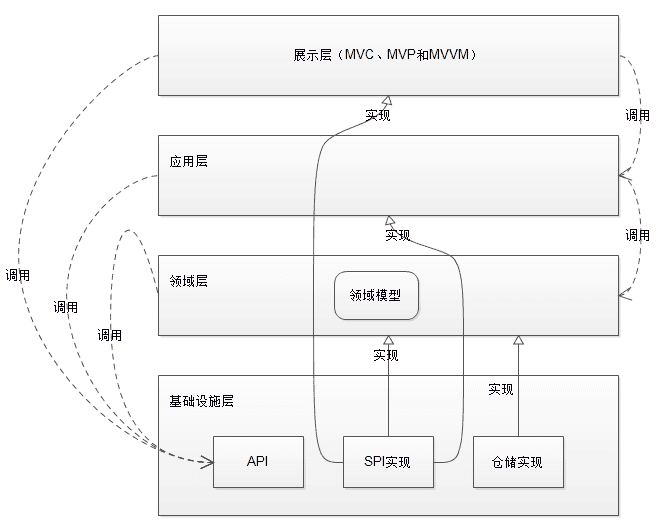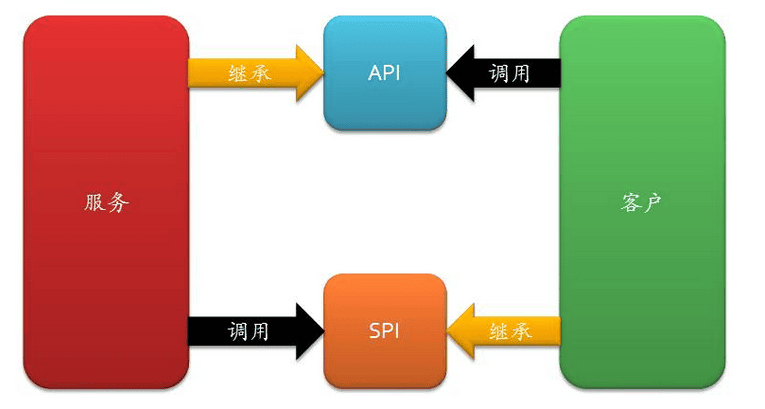Java 基础之SPI机制
Java 基础之SPI机制
SPI(Service Provider Interface),是JDK内置的一种 服务提供发现机制,可以用来启用框架扩展和替换组件,主要是被框架的开发人员使用。
- Java常用机制 - SPI机制
- 什么是SPI机制
- SPI机制的简单示例
- SPI机制的广泛应用
- SPI机制 - JDBC DriverManager
- SPI机制 - Common-Logging
- SPI机制 - 插件体系
- SPI机制 - Spring中SPI机制
- SPI机制深入理解
- 参考文章
# 什么是SPI机制
SPI(Service Provider Interface),是JDK内置的一种 服务提供发现机制,可以用来启用框架扩展和替换组件,主要是被框架的开发人员使用,比如java.sql.Driver接口,其他不同厂商可以针对同一接口做出不同的实现,MySQL和PostgreSQL都有不同的实现提供给用户,而Java的SPI机制可以为某个接口寻找服务实现。Java中SPI机制主要思想是将装配的控制权移到程序之外,在模块化设计中这个机制尤其重要,其核心思想就是 解耦。
SPI整体机制图如下:

当服务的提供者提供了一种接口的实现之后,需要在classpath下的META-INF/services/目录里创建一个以服务接口命名的文件,这个文件里的内容就是这个接口的具体的实现类。当其他的程序需要这个服务的时候,就可以通过查找这个jar包(一般都是以jar包做依赖)的META-INF/services/中的配置文件,配置文件中有接口的具体实现类名,可以根据这个类名进行加载实例化,就可以使用该服务了。JDK中查找服务的实现的工具类是:java.util.ServiceLoader。
# SPI机制的简单示例
网上找了个例子:这里在新窗口打开
我们现在需要使用一个内容搜索接口,搜索的实现可能是基于文件系统的搜索,也可能是基于数据库的搜索。
- 先定义好接口
public interface Search {
public List<String> searchDoc(String keyword);
}- 文件搜索实现
public class FileSearch implements Search{
@Override
public List<String> searchDoc(String keyword) {
System.out.println("文件搜索 "+keyword);
return null;
}
}- 数据库搜索实现
public class DatabaseSearch implements Search{
@Override
public List<String> searchDoc(String keyword) {
System.out.println("数据搜索 "+keyword);
return null;
}
}- resources 接下来可以在resources下新建META-INF/services/目录,然后新建接口全限定名的文件:
com.cainiao.ys.spi.learn.Search,里面加上我们需要用到的实现类
com.cainiao.ys.spi.learn.FileSearch- 测试方法
public class TestCase {
public static void main(String[] args) {
ServiceLoader<Search> s = ServiceLoader.load(Search.class);
Iterator<Search> iterator = s.iterator();
while (iterator.hasNext()) {
Search search = iterator.next();
search.searchDoc("hello world");
}
}
}可以看到输出结果:文件搜索 hello world
如果在com.cainiao.ys.spi.learn.Search文件里写上两个实现类,那最后的输出结果就是两行了。
这就是因为ServiceLoader.load(Search.class)在加载某接口时,会去META-INF/services下找接口的全限定名文件,再根据里面的内容加载相应的实现类。
这就是spi的思想,接口的实现由provider实现,provider只用在提交的jar包里的META-INF/services下根据平台定义的接口新建文件,并添加进相应的实现类内容就好。
# SPI机制的广泛应用
# SPI机制 - JDBC DriverManager
在JDBC4.0之前,我们开发有连接数据库的时候,通常会用Class.forName("com.mysql.jdbc.Driver")这句先加载数据库相关的驱动,然后再进行获取连接等的操作。而JDBC4.0之后不需要用Class.forName("com.mysql.jdbc.Driver")来加载驱动,直接获取连接就可以了,现在这种方式就是使用了Java的SPI扩展机制来实现。
# JDBC接口定义
首先在java中定义了接口java.sql.Driver,并没有具体的实现,具体的实现都是由不同厂商来提供的。
# mysql实现
在mysql的jar包mysql-connector-java-6.0.6.jar中,可以找到META-INF/services目录,该目录下会有一个名字为java.sql.Driver的文件,文件内容是com.mysql.cj.jdbc.Driver,这里面的内容就是针对Java中定义的接口的实现。
# postgresql实现
同样在postgresql的jar包postgresql-42.0.0.jar中,也可以找到同样的配置文件,文件内容是org.postgresql.Driver,这是postgresql对Java的java.sql.Driver的实现。
# 使用方法
上面说了,现在使用SPI扩展来加载具体的驱动,我们在Java中写连接数据库的代码的时候,不需要再使用Class.forName("com.mysql.jdbc.Driver")来加载驱动了,而是直接使用如下代码:
String url = "jdbc:xxxx://xxxx:xxxx/xxxx";
Connection conn = DriverManager.getConnection(url,username,password);
.....这里并没有涉及到spi的使用,接着看下面的解析。
# 源码实现
上面的使用方法,就是我们普通的连接数据库的代码,并没有涉及到SPI的东西,但是有一点我们可以确定的是,我们没有写有关具体驱动的硬编码Class.forName("com.mysql.jdbc.Driver")!
上面的代码可以直接获取数据库连接进行操作,但是跟SPI有啥关系呢?上面代码没有了加载驱动的代码,我们怎么去确定使用哪个数据库连接的驱动呢?这里就涉及到使用Java的SPI扩展机制来查找相关驱动的东西了,关于驱动的查找其实都在DriverManager中,DriverManager是Java中的实现,用来获取数据库连接,在DriverManager中有一个静态代码块如下:
static {
loadInitialDrivers();
println("JDBC DriverManager initialized");
}可以看到是加载实例化驱动的,接着看loadInitialDrivers方法:
private static void loadInitialDrivers() {
String drivers;
try {
drivers = AccessController.doPrivileged(new PrivilegedAction<String>() {
public String run() {
return System.getProperty("jdbc.drivers");
}
});
} catch (Exception ex) {
drivers = null;
}
AccessController.doPrivileged(new PrivilegedAction<Void>() {
public Void run() {
//使用SPI的ServiceLoader来加载接口的实现
ServiceLoader<Driver> loadedDrivers = ServiceLoader.load(Driver.class);
Iterator<Driver> driversIterator = loadedDrivers.iterator();
try{
while(driversIterator.hasNext()) {
driversIterator.next();
}
} catch(Throwable t) {
// Do nothing
}
return null;
}
});
println("DriverManager.initialize: jdbc.drivers = " + drivers);
if (drivers == null || drivers.equals("")) {
return;
}
String[] driversList = drivers.split(":");
println("number of Drivers:" + driversList.length);
for (String aDriver : driversList) {
try {
println("DriverManager.Initialize: loading " + aDriver);
Class.forName(aDriver, true,
ClassLoader.getSystemClassLoader());
} catch (Exception ex) {
println("DriverManager.Initialize: load failed: " + ex);
}
}
}上面的代码主要步骤是:
- 从系统变量中获取有关驱动的定义。
- 使用SPI来获取驱动的实现。
- 遍历使用SPI获取到的具体实现,实例化各个实现类。
- 根据第一步获取到的驱动列表来实例化具体实现类。
我们主要关注2,3步,这两步是SPI的用法,首先看第二步,使用SPI来获取驱动的实现,对应的代码是:
ServiceLoader<Driver> loadedDrivers = ServiceLoader.load(Driver.class);这里没有去META-INF/services目录下查找配置文件,也没有加载具体实现类,做的事情就是封装了我们的接口类型和类加载器,并初始化了一个迭代器。
接着看第三步,遍历使用SPI获取到的具体实现,实例化各个实现类,对应的代码如下:
//获取迭代器
Iterator<Driver> driversIterator = loadedDrivers.iterator();
//遍历所有的驱动实现
while(driversIterator.hasNext()) {
driversIterator.next();
}在遍历的时候,首先调用driversIterator.hasNext()方法,这里会搜索classpath下以及jar包中所有的META-INF/services目录下的java.sql.Driver文件,并找到文件中的实现类的名字,此时并没有实例化具体的实现类(ServiceLoader具体的源码实现在下面)。
然后是调用driversIterator.next();方法,此时就会根据驱动名字具体实例化各个实现类了。现在驱动就被找到并实例化了。
可以看下截图,我在测试项目中添加了两个jar包,mysql-connector-java-6.0.6.jar和postgresql-42.0.0.0.jar,跟踪到DriverManager中之后:

可以看到此时迭代器中有两个驱动,mysql和postgresql的都被加载了。
# SPI机制 - Common-Logging
common-logging(也称Jakarta Commons Logging,缩写 JCL)是常用的日志库门面,具体日志库相关可以看这篇。我们看下它是怎么解耦的。
首先,日志实例是通过LogFactory的getLog(String)方法创建的:
public static getLog(Class clazz) throws LogConfigurationException {
return getFactory().getInstance(clazz);
}LogFatory是一个抽象类,它负责加载具体的日志实现,分析其Factory getFactory()方法:
public static org.apache.commons.logging.LogFactory getFactory() throws LogConfigurationException {
// Identify the class loader we will be using
ClassLoader contextClassLoader = getContextClassLoaderInternal();
if (contextClassLoader == null) {
// This is an odd enough situation to report about. This
// output will be a nuisance on JDK1.1, as the system
// classloader is null in that environment.
if (isDiagnosticsEnabled()) {
logDiagnostic("Context classloader is null.");
}
}
// Return any previously registered factory for this class loader
org.apache.commons.logging.LogFactory factory = getCachedFactory(contextClassLoader);
if (factory != null) {
return factory;
}
if (isDiagnosticsEnabled()) {
logDiagnostic(
"[LOOKUP] LogFactory implementation requested for the first time for context classloader " +
objectId(contextClassLoader));
logHierarchy("[LOOKUP] ", contextClassLoader);
}
// Load properties file.
//
// If the properties file exists, then its contents are used as
// "attributes" on the LogFactory implementation class. One particular
// property may also control which LogFactory concrete subclass is
// used, but only if other discovery mechanisms fail..
//
// As the properties file (if it exists) will be used one way or
// another in the end we may as well look for it first.
// classpath根目录下寻找commons-logging.properties
Properties props = getConfigurationFile(contextClassLoader, FACTORY_PROPERTIES);
// Determine whether we will be using the thread context class loader to
// load logging classes or not by checking the loaded properties file (if any).
// classpath根目录下commons-logging.properties是否配置use_tccl
ClassLoader baseClassLoader = contextClassLoader;
if (props != null) {
String useTCCLStr = props.getProperty(TCCL_KEY);
if (useTCCLStr != null) {
// The Boolean.valueOf(useTCCLStr).booleanValue() formulation
// is required for Java 1.2 compatibility.
if (Boolean.valueOf(useTCCLStr).booleanValue() == false) {
// Don't use current context classloader when locating any
// LogFactory or Log classes, just use the class that loaded
// this abstract class. When this class is deployed in a shared
// classpath of a container, it means webapps cannot deploy their
// own logging implementations. It also means that it is up to the
// implementation whether to load library-specific config files
// from the TCCL or not.
baseClassLoader = thisClassLoader;
}
}
}
// 这里真正开始决定使用哪个factory
// 首先,尝试查找vm系统属性org.apache.commons.logging.LogFactory,其是否指定factory
// Determine which concrete LogFactory subclass to use.
// First, try a global system property
if (isDiagnosticsEnabled()) {
logDiagnostic("[LOOKUP] Looking for system property [" + FACTORY_PROPERTY +
"] to define the LogFactory subclass to use...");
}
try {
String factoryClass = getSystemProperty(FACTORY_PROPERTY, null);
if (factoryClass != null) {
if (isDiagnosticsEnabled()) {
logDiagnostic("[LOOKUP] Creating an instance of LogFactory class '" + factoryClass +
"' as specified by system property " + FACTORY_PROPERTY);
}
factory = newFactory(factoryClass, baseClassLoader, contextClassLoader);
} else {
if (isDiagnosticsEnabled()) {
logDiagnostic("[LOOKUP] No system property [" + FACTORY_PROPERTY + "] defined.");
}
}
} catch (SecurityException e) {
if (isDiagnosticsEnabled()) {
logDiagnostic("[LOOKUP] A security exception occurred while trying to create an" +
" instance of the custom factory class" + ": [" + trim(e.getMessage()) +
"]. Trying alternative implementations...");
}
// ignore
} catch (RuntimeException e) {
// This is not consistent with the behaviour when a bad LogFactory class is
// specified in a services file.
//
// One possible exception that can occur here is a ClassCastException when
// the specified class wasn't castable to this LogFactory type.
if (isDiagnosticsEnabled()) {
logDiagnostic("[LOOKUP] An exception occurred while trying to create an" +
" instance of the custom factory class" + ": [" +
trim(e.getMessage()) +
"] as specified by a system property.");
}
throw e;
}
// 第二,尝试使用java spi服务发现机制,载META-INF/services下寻找org.apache.commons.logging.LogFactory实现
// Second, try to find a service by using the JDK1.3 class
// discovery mechanism, which involves putting a file with the name
// of an interface class in the META-INF/services directory, where the
// contents of the file is a single line specifying a concrete class
// that implements the desired interface.
if (factory == null) {
if (isDiagnosticsEnabled()) {
logDiagnostic("[LOOKUP] Looking for a resource file of name [" + SERVICE_ID +
"] to define the LogFactory subclass to use...");
}
try {
// META-INF/services/org.apache.commons.logging.LogFactory, SERVICE_ID
final InputStream is = getResourceAsStream(contextClassLoader, SERVICE_ID);
if (is != null) {
// This code is needed by EBCDIC and other strange systems.
// It's a fix for bugs reported in xerces
BufferedReader rd;
try {
rd = new BufferedReader(new InputStreamReader(is, "UTF-8"));
} catch (java.io.UnsupportedEncodingException e) {
rd = new BufferedReader(new InputStreamReader(is));
}
String factoryClassName = rd.readLine();
rd.close();
if (factoryClassName != null && !"".equals(factoryClassName)) {
if (isDiagnosticsEnabled()) {
logDiagnostic("[LOOKUP] Creating an instance of LogFactory class " +
factoryClassName +
" as specified by file '" + SERVICE_ID +
"' which was present in the path of the context classloader.");
}
factory = newFactory(factoryClassName, baseClassLoader, contextClassLoader);
}
} else {
// is == null
if (isDiagnosticsEnabled()) {
logDiagnostic("[LOOKUP] No resource file with name '" + SERVICE_ID + "' found.");
}
}
} catch (Exception ex) {
// note: if the specified LogFactory class wasn't compatible with LogFactory
// for some reason, a ClassCastException will be caught here, and attempts will
// continue to find a compatible class.
if (isDiagnosticsEnabled()) {
logDiagnostic(
"[LOOKUP] A security exception occurred while trying to create an" +
" instance of the custom factory class" +
": [" + trim(ex.getMessage()) +
"]. Trying alternative implementations...");
}
// ignore
}
}
// 第三,尝试从classpath根目录下的commons-logging.properties中查找org.apache.commons.logging.LogFactory属性指定的factory
// Third try looking into the properties file read earlier (if found)
if (factory == null) {
if (props != null) {
if (isDiagnosticsEnabled()) {
logDiagnostic(
"[LOOKUP] Looking in properties file for entry with key '" + FACTORY_PROPERTY +
"' to define the LogFactory subclass to use...");
}
String factoryClass = props.getProperty(FACTORY_PROPERTY);
if (factoryClass != null) {
if (isDiagnosticsEnabled()) {
logDiagnostic(
"[LOOKUP] Properties file specifies LogFactory subclass '" + factoryClass + "'");
}
factory = newFactory(factoryClass, baseClassLoader, contextClassLoader);
// TODO: think about whether we need to handle exceptions from newFactory
} else {
if (isDiagnosticsEnabled()) {
logDiagnostic("[LOOKUP] Properties file has no entry specifying LogFactory subclass.");
}
}
} else {
if (isDiagnosticsEnabled()) {
logDiagnostic("[LOOKUP] No properties file available to determine" + " LogFactory subclass from..");
}
}
}
// 最后,使用后备factory实现,org.apache.commons.logging.impl.LogFactoryImpl
// Fourth, try the fallback implementation class
if (factory == null) {
if (isDiagnosticsEnabled()) {
logDiagnostic(
"[LOOKUP] Loading the default LogFactory implementation '" + FACTORY_DEFAULT +
"' via the same classloader that loaded this LogFactory" +
" class (ie not looking in the context classloader).");
}
// Note: unlike the above code which can try to load custom LogFactory
// implementations via the TCCL, we don't try to load the default LogFactory
// implementation via the context classloader because:
// * that can cause problems (see comments in newFactory method)
// * no-one should be customising the code of the default class
// Yes, we do give up the ability for the child to ship a newer
// version of the LogFactoryImpl class and have it used dynamically
// by an old LogFactory class in the parent, but that isn't
// necessarily a good idea anyway.
factory = newFactory(FACTORY_DEFAULT, thisClassLoader, contextClassLoader);
}
if (factory != null) {
/**
* Always cache using context class loader.
*/
cacheFactory(contextClassLoader, factory);
if (props != null) {
Enumeration names = props.propertyNames();
while (names.hasMoreElements()) {
String name = (String) names.nextElement();
String value = props.getProperty(name);
factory.setAttribute(name, value);
}
}
}
return factory;
}可以看出,抽象类LogFactory加载具体实现的步骤如下:
- 从vm系统属性org.apache.commons.logging.LogFactory
- 使用SPI服务发现机制,发现org.apache.commons.logging.LogFactory的实现
- 查找classpath根目录commons-logging.properties的org.apache.commons.logging.LogFactory属性是否指定factory实现
- 使用默认factory实现,org.apache.commons.logging.impl.LogFactoryImpl
LogFactory的getLog()方法返回类型是org.apache.commons.logging.Log接口,提供了从trace到fatal方法。可以确定,如果日志实现提供者只要实现该接口,并且使用继承自org.apache.commons.logging.LogFactory的子类创建Log,必然可以构建一个松耦合的日志系统。
# SPI机制 - 插件体系
其实最具spi思想的应该属于插件开发,我们项目中也用到的这种思想,后面再说,这里具体说一下eclipse的插件思想。
Eclipse使用OSGi作为插件系统的基础,动态添加新插件和停止现有插件,以动态的方式管理组件生命周期。
一般来说,插件的文件结构必须在指定目录下包含以下三个文件:
META-INF/MANIFEST.MF: 项目基本配置信息,版本、名称、启动器等build.properties: 项目的编译配置信息,包括,源代码路径、输出路径plugin.xml:插件的操作配置信息,包含弹出菜单及点击菜单后对应的操作执行类等
当eclipse启动时,会遍历plugins文件夹中的目录,扫描每个插件的清单文件MANIFEST.MF,并建立一个内部模型来记录它所找到的每个插件的信息,就实现了动态添加新的插件。
这也意味着是eclipse制定了一系列的规则,像是文件结构、类型、参数等。插件开发者遵循这些规则去开发自己的插件,eclipse并不需要知道插件具体是怎样开发的,只需要在启动的时候根据配置文件解析、加载到系统里就好了,是spi思想的一种体现。
# SPI机制 - Spring中SPI机制
在springboot的自动装配过程中,最终会加载META-INF/spring.factories文件,而加载的过程是由SpringFactoriesLoader加载的。从CLASSPATH下的每个Jar包中搜寻所有META-INF/spring.factories配置文件,然后将解析properties文件,找到指定名称的配置后返回。需要注意的是,其实这里不仅仅是会去ClassPath路径下查找,会扫描所有路径下的Jar包,只不过这个文件只会在Classpath下的jar包中。
public static final String FACTORIES_RESOURCE_LOCATION = "META-INF/spring.factories";
// spring.factories文件的格式为:key=value1,value2,value3
// 从所有的jar包中找到META-INF/spring.factories文件
// 然后从文件中解析出key=factoryClass类名称的所有value值
public static List<String> loadFactoryNames(Class<?> factoryClass, ClassLoader classLoader) {
String factoryClassName = factoryClass.getName();
// 取得资源文件的URL
Enumeration<URL> urls = (classLoader != null ? classLoader.getResources(FACTORIES_RESOURCE_LOCATION) : ClassLoader.getSystemResources(FACTORIES_RESOURCE_LOCATION));
List<String> result = new ArrayList<String>();
// 遍历所有的URL
while (urls.hasMoreElements()) {
URL url = urls.nextElement();
// 根据资源文件URL解析properties文件,得到对应的一组@Configuration类
Properties properties = PropertiesLoaderUtils.loadProperties(new UrlResource(url));
String factoryClassNames = properties.getProperty(factoryClassName);
// 组装数据,并返回
result.addAll(Arrays.asList(StringUtils.commaDelimitedListToStringArray(factoryClassNames)));
}
return result;
}# SPI机制深入理解
提示
接下来,我们深入理解下SPI相关内容
# SPI机制通常怎么使用
看完上面的几个例子解析,应该都能知道大概的流程了:
- 有关组织或者公司定义标准。
- 具体厂商或者框架开发者实现。
- 程序猿使用。
# 定义标准
定义标准,就是定义接口。比如接口java.sql.Driver
# 具体厂商或者框架开发者实现
厂商或者框架开发者开发具体的实现:
在META-INF/services目录下定义一个名字为接口全限定名的文件,比如java.sql.Driver文件,文件内容是具体的实现名字,比如me.cxis.sql.MyDriver。
写具体的实现me.cxis.sql.MyDriver,都是对接口Driver的实现。
# 程序猿使用
我们会引用具体厂商的jar包来实现我们的功能:
ServiceLoader<Driver> loadedDrivers = ServiceLoader.load(Driver.class);
//获取迭代器
Iterator<Driver> driversIterator = loadedDrivers.iterator();
//遍历
while(driversIterator.hasNext()) {
driversIterator.next();
//可以做具体的业务逻辑
}# 使用规范
最后总结一下jdk spi需要遵循的规范

# SPI和API的区别是什么
这里实际包含两个问题,第一个SPI和API的区别?第二个什么时候用API,什么时候用SPI?
SPI - “接口”位于“调用方”所在的“包”中
- 概念上更依赖调用方。
- 组织上位于调用方所在的包中。
- 实现位于独立的包中。
- 常见的例子是:插件模式的插件。
API - “接口”位于“实现方”所在的“包”中
- 概念上更接近实现方。
- 组织上位于实现方所在的包中。
- 实现和接口在一个包中。
参考:


# SPI机制实现原理
不妨看下JDK中ServiceLoader<S>方法的具体实现:
//ServiceLoader实现了Iterable接口,可以遍历所有的服务实现者
public final class ServiceLoader<S>
implements Iterable<S>
{
//查找配置文件的目录
private static final String PREFIX = "META-INF/services/";
//表示要被加载的服务的类或接口
private final Class<S> service;
//这个ClassLoader用来定位,加载,实例化服务提供者
private final ClassLoader loader;
// 访问控制上下文
private final AccessControlContext acc;
// 缓存已经被实例化的服务提供者,按照实例化的顺序存储
private LinkedHashMap<String,S> providers = new LinkedHashMap<>();
// 迭代器
private LazyIterator lookupIterator;
//重新加载,就相当于重新创建ServiceLoader了,用于新的服务提供者安装到正在运行的Java虚拟机中的情况。
public void reload() {
//清空缓存中所有已实例化的服务提供者
providers.clear();
//新建一个迭代器,该迭代器会从头查找和实例化服务提供者
lookupIterator = new LazyIterator(service, loader);
}
//私有构造器
//使用指定的类加载器和服务创建服务加载器
//如果没有指定类加载器,使用系统类加载器,就是应用类加载器。
private ServiceLoader(Class<S> svc, ClassLoader cl) {
service = Objects.requireNonNull(svc, "Service interface cannot be null");
loader = (cl == null) ? ClassLoader.getSystemClassLoader() : cl;
acc = (System.getSecurityManager() != null) ? AccessController.getContext() : null;
reload();
}
//解析失败处理的方法
private static void fail(Class<?> service, String msg, Throwable cause)
throws ServiceConfigurationError
{
throw new ServiceConfigurationError(service.getName() + ": " + msg,
cause);
}
private static void fail(Class<?> service, String msg)
throws ServiceConfigurationError
{
throw new ServiceConfigurationError(service.getName() + ": " + msg);
}
private static void fail(Class<?> service, URL u, int line, String msg)
throws ServiceConfigurationError
{
fail(service, u + ":" + line + ": " + msg);
}
//解析服务提供者配置文件中的一行
//首先去掉注释校验,然后保存
//返回下一行行号
//重复的配置项和已经被实例化的配置项不会被保存
private int parseLine(Class<?> service, URL u, BufferedReader r, int lc,
List<String> names)
throws IOException, ServiceConfigurationError
{
//读取一行
String ln = r.readLine();
if (ln == null) {
return -1;
}
//#号代表注释行
int ci = ln.indexOf('#');
if (ci >= 0) ln = ln.substring(0, ci);
ln = ln.trim();
int n = ln.length();
if (n != 0) {
if ((ln.indexOf(' ') >= 0) || (ln.indexOf('\t') >= 0))
fail(service, u, lc, "Illegal configuration-file syntax");
int cp = ln.codePointAt(0);
if (!Character.isJavaIdentifierStart(cp))
fail(service, u, lc, "Illegal provider-class name: " + ln);
for (int i = Character.charCount(cp); i < n; i += Character.charCount(cp)) {
cp = ln.codePointAt(i);
if (!Character.isJavaIdentifierPart(cp) && (cp != '.'))
fail(service, u, lc, "Illegal provider-class name: " + ln);
}
if (!providers.containsKey(ln) && !names.contains(ln))
names.add(ln);
}
return lc + 1;
}
//解析配置文件,解析指定的url配置文件
//使用parseLine方法进行解析,未被实例化的服务提供者会被保存到缓存中去
private Iterator<String> parse(Class<?> service, URL u)
throws ServiceConfigurationError
{
InputStream in = null;
BufferedReader r = null;
ArrayList<String> names = new ArrayList<>();
try {
in = u.openStream();
r = new BufferedReader(new InputStreamReader(in, "utf-8"));
int lc = 1;
while ((lc = parseLine(service, u, r, lc, names)) >= 0);
}
return names.iterator();
}
//服务提供者查找的迭代器
private class LazyIterator
implements Iterator<S>
{
Class<S> service;//服务提供者接口
ClassLoader loader;//类加载器
Enumeration<URL> configs = null;//保存实现类的url
Iterator<String> pending = null;//保存实现类的全名
String nextName = null;//迭代器中下一个实现类的全名
private LazyIterator(Class<S> service, ClassLoader loader) {
this.service = service;
this.loader = loader;
}
private boolean hasNextService() {
if (nextName != null) {
return true;
}
if (configs == null) {
try {
String fullName = PREFIX + service.getName();
if (loader == null)
configs = ClassLoader.getSystemResources(fullName);
else
configs = loader.getResources(fullName);
}
}
while ((pending == null) || !pending.hasNext()) {
if (!configs.hasMoreElements()) {
return false;
}
pending = parse(service, configs.nextElement());
}
nextName = pending.next();
return true;
}
private S nextService() {
if (!hasNextService())
throw new NoSuchElementException();
String cn = nextName;
nextName = null;
Class<?> c = null;
try {
c = Class.forName(cn, false, loader);
}
if (!service.isAssignableFrom(c)) {
fail(service, "Provider " + cn + " not a subtype");
}
try {
S p = service.cast(c.newInstance());
providers.put(cn, p);
return p;
}
}
public boolean hasNext() {
if (acc == null) {
return hasNextService();
} else {
PrivilegedAction<Boolean> action = new PrivilegedAction<Boolean>() {
public Boolean run() { return hasNextService(); }
};
return AccessController.doPrivileged(action, acc);
}
}
public S next() {
if (acc == null) {
return nextService();
} else {
PrivilegedAction<S> action = new PrivilegedAction<S>() {
public S run() { return nextService(); }
};
return AccessController.doPrivileged(action, acc);
}
}
public void remove() {
throw new UnsupportedOperationException();
}
}
//获取迭代器
//返回遍历服务提供者的迭代器
//以懒加载的方式加载可用的服务提供者
//懒加载的实现是:解析配置文件和实例化服务提供者的工作由迭代器本身完成
public Iterator<S> iterator() {
return new Iterator<S>() {
//按照实例化顺序返回已经缓存的服务提供者实例
Iterator<Map.Entry<String,S>> knownProviders
= providers.entrySet().iterator();
public boolean hasNext() {
if (knownProviders.hasNext())
return true;
return lookupIterator.hasNext();
}
public S next() {
if (knownProviders.hasNext())
return knownProviders.next().getValue();
return lookupIterator.next();
}
public void remove() {
throw new UnsupportedOperationException();
}
};
}
//为指定的服务使用指定的类加载器来创建一个ServiceLoader
public static <S> ServiceLoader<S> load(Class<S> service,
ClassLoader loader)
{
return new ServiceLoader<>(service, loader);
}
//使用线程上下文的类加载器来创建ServiceLoader
public static <S> ServiceLoader<S> load(Class<S> service) {
ClassLoader cl = Thread.currentThread().getContextClassLoader();
return ServiceLoader.load(service, cl);
}
//使用扩展类加载器为指定的服务创建ServiceLoader
//只能找到并加载已经安装到当前Java虚拟机中的服务提供者,应用程序类路径中的服务提供者将被忽略
public static <S> ServiceLoader<S> loadInstalled(Class<S> service) {
ClassLoader cl = ClassLoader.getSystemClassLoader();
ClassLoader prev = null;
while (cl != null) {
prev = cl;
cl = cl.getParent();
}
return ServiceLoader.load(service, prev);
}
public String toString() {
return "java.util.ServiceLoader[" + service.getName() + "]";
}
}首先,ServiceLoader实现了Iterable接口,所以它有迭代器的属性,这里主要都是实现了迭代器的hasNext和next方法。这里主要都是调用的lookupIterator的相应hasNext和next方法,lookupIterator是懒加载迭代器。
其次,LazyIterator中的hasNext方法,静态变量PREFIX就是”META-INF/services/”目录,这也就是为什么需要在classpath下的META-INF/services/目录里创建一个以服务接口命名的文件。
最后,通过反射方法Class.forName()加载类对象,并用newInstance方法将类实例化,并把实例化后的类缓存到providers对象中,(LinkedHashMap<String,S>类型)然后返回实例对象。
所以我们可以看到ServiceLoader不是实例化以后,就去读取配置文件中的具体实现,并进行实例化。而是等到使用迭代器去遍历的时候,才会加载对应的配置文件去解析,调用hasNext方法的时候会去加载配置文件进行解析,调用next方法的时候进行实例化并缓存。
所有的配置文件只会加载一次,服务提供者也只会被实例化一次,重新加载配置文件可使用reload方法。
# SPI机制的缺陷
通过上面的解析,可以发现,我们使用SPI机制的缺陷:
- 不能按需加载,需要遍历所有的实现,并实例化,然后在循环中才能找到我们需要的实现。如果不想用某些实现类,或者某些类实例化很耗时,它也被载入并实例化了,这就造成了浪费。
- 获取某个实现类的方式不够灵活,只能通过 Iterator 形式获取,不能根据某个参数来获取对应的实现类。
- 多个并发多线程使用 ServiceLoader 类的实例是不安全的。